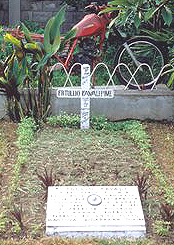When I think of Tullio (killed on 11 April 1985) I think of the burnt remains of his motorcycle cemented near his grave in the garden of the bishop’s residence in Kidapawan. A means of transport that helped him move on the tiring and unfortunate mission of Tulunan, a large peasant village located in the center of the island of Mindanao. Of that new red Honda 125, set on fire by a group of assassins, only a skeleton of rusty pipes remained. Today that wreck reminds me of old images of children who occasionally played around it. Always curious, they touched that old ruin with the liquefied tires and asked themselves: “Why then? Are motorbikes also born and die? Do they have a soul? Do they get married and dream of small bicycles? Some of the older ones responded by smiling, beginning with: “Once upon a time there was an Italian missionary” or “Once upon a time there was a red Japanese four-stroke motorbike…” Incipit of different stories that would lead to the same painful conclusion.
A mechanical device made of wire, steel and rubber that shares our history, life and death, is not difficult to understand. Tullio then, I now and others like me, have always needed low and widespread technologies, at hand, to speed up our daily work. After all, motorcycles, cars and now computers and smartphones are complex devices that instill dynamism and save time in human activities. The motorbike, in particular, remains an easy vehicle to manoeuvre. It trains you to compromise and teaches you to deal with continuous change; the eye with the mirror, the trajectory with the driver, the driver with the engine, the engine with the wheels, the wheels with the brake, the brake with the foot and the obstacle to avoid on the right or left. A metaphor for the obstacle course in real life.
But these mechanisms, if owned by a lucky few, are symbols of power. In the typical rural village of Mindanao, someone like me can own the same means of transportation as the mayor, the shopkeeper and the doctor, thus entering the category of privileged men. Already today, seeing a priest walking on foot, or on a borrowed donkey, seems out of place. Yet, years ago, without transportation, I felt no different from the farmers of Arakan, Payao, or Sibuco. While I was looking for possible shortcuts and studying the times of adaptation to nature, its ups and downs. Then, with the multiplication of activities, nature became an obstacle. It limited travel, delayed communications. We wanted more efficient technology for a more efficient church. Naturally, priority had to be given to the most distant and needy communities, to be reached in the shortest possible time. But it had already been like this around us for a long time. We imitated others. With the arrival of motors, a small radio, a large stereo, a color television, a karaoke machine, a tiny tractor, a chainsaw and so on, suddenly the machines had multiplied in a continuous triumph over nature. However, the number of Christian communities to be reached has also increased. The fact is that, perhaps, we soon forgot the rhythms of the past to project ourselves into the future; uncertain for humans, promising for the technology industry.
So it is, we have left behind that piece of humanity that loved to linger. Well … yes! How many times, sitting on top of the hot engine of a motorbike, have I observed the long strips of wet rice spread out to dry on the dirt road, taking up almost its entirety? Did they perhaps hinder me in my running? NO! Mine was just a solitary and imperious passage. I was master of the road, except for the discomfort of seeing in the rear-view mirror the old lady tidying up the rice scattered by my rattling passage. This is how she is. Technological progress, used without due attention, has inexorably distanced me from the lifestyle that I would have liked to have remained.
Finally, there is a more bitter implication. When we want to serve others with better results, help as many people as possible, multiply messages of good will, our own machines collide with the prevailing ones of others that deny and obstruct the flow of life.
Thus Bucay, the leader of the pack, who first sets fire to Tullio’s motorbike and then kills the priest to slow down time to a pace marked only by fear, slow, deadly and primordial, using another type of technology; the machine gun. Thus, a few years later, Salvatore collapses with his bleeding head on the steering wheel of the car, while he is returning home after a conversation with Muslim friends. He was killed with an American-made gun by two hitmen riding on a Japanese motorcycle. This is what will happen years later to Fausto, who was riddled, while opening the door of his Korean jeep, by counterfeit bullets intended to cause multiple internal lacerations.
The motorbike used by Tullio met a dignified end, rusting next to his bones buried there, but the machine guns and pistols continue to pass from hand to hand. No illusions, there will always be dirty technology used by people without common sense, without empathy for the lives of others, which will always try to break the backs of innocent motorists who are however increasingly convinced that they have taken the right path.

